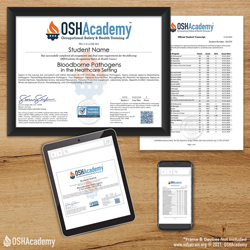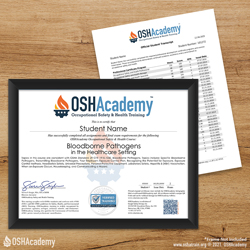Introduction
This course is designed to provide students with the necessary knowledge to help reduce or eliminate the occupational risk of bloodborne pathogens in various healthcare settings. The goal of this course is to help students understand the risks and develop behaviors to help protect them when exposed to potentially infectious materials, such as blood.
This course is based on both 655 Bloodborne Pathogens in the Workplace and 755 Bloodborne Pathogens Program Management. However, it also includes additional information on needlestick safety, universal precautions, laboratory safety, and more.
OSHA requires that bloodborne pathogens safety training meets the specific needs of the employee, such as those working in the healthcare industry. This course is designed to help meet those specific needs.
This course supports bloodborne pathogens OSHA training requirements in the healthcare setting. Students can ask questions and get feedback through our website or by email while taking this course. This is a very important aspect of online training and is required to meet OSHA standards.
This course is consistent with OSHA Bloodborne Pathogens Standard 29 CFR 1910.1030.
Course Objectives
| ID | Objective |
|---|---|
| TO 1.0 | Achieve a minimum score of 70% on the final course assessment. |
| LO 1.1.1 | Define and give examples of bloodborne pathogens. |
| LO 1.2.1 | Describe the characteristics, symptoms, exposure routes, and treatment of specific bloodborne pathogens. |
| LO 1.3.1 | Describe how bloodborne pathogens may be transmitted. |
| LO 1.4.1 | Describe the employer Exposure Control Program. |
| LO 1.5.1 | Discuss and give examples of jobs at increased risk of exposure to bloodborne pathogens. |
| LO 1.6.1 | Describe exposure control methods and personal protective equipment. |
| LO 1.7.1 | Discuss safety precautions and practices to reduce needlestick injuries. |
| LO 1.8.1 | Define and describe the application of "universal" and "standard" safety precautions. |
| LO 1.9.1 | Describe and give examples of personal protective equipment used to protect against exposure to bloodborne pathogens. |
| LO 1.10.1 | Discuss safety precautions in the laboratory facility. |
| LO 1.11.1 | Discuss employer responsibilities associated with providing Hepatitis B (HBV) immunizations. |
| LO 1.12.1 | Describe reporting and response procedures when an exposure to bloodborne pathogens occurs. |
| LO 1.13.1 | Discuss good housekeeping procedures emphasizing procedures for contaminated material. |
| LO 1.14.1 | Describe training requirements and other methods to communicate the hazards of bloodborne pathogens in the workplace. |
Key: Terminal Objective (TO), Learning Objective (LO)



